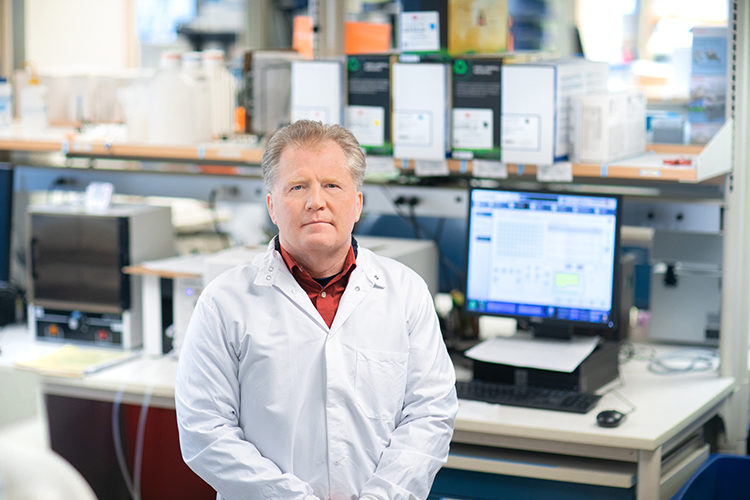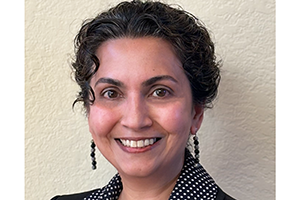For Brian Curtis, blood is in his blood.
Curtis, who earned his doctorate in health sciences and immunology from UWM, is a scientist who is senior director of diagnostic hematology laboratories for Versiti Blood Center of Wisconsin (formerly known as the BloodCenter of Wisconsin).
Most people associate the blood center with blood drives, said Curtis, and the organization does provide 230,000 units of blood annually to hospitals.
However, research is also a critical part of Versiti’s work, according to Curtis. The center’s labs study blood-related diseases, transfusion medicine and transplantation. Most recently, for example, Versiti has been involved in studies of the use of plasma from patients who’ve recovered from COVID-19 to treat those suffering from the disease.
And Versiti, along with UWM, is part of a consortium of eight regional institutions dedicated to clinical and translational research and training. That consortium, the Clinical and Translational Science Institute of Southeast Wisconsin, recently received five-year $24.4 million grant to continue its work of translating research discoveries into patient care. (Curtis is an adjunct professor in the CTSI at one of the institutions, the Medical College of Wisconsin).
Research is a draw
The Blood Center’s research focus was what originally attracted him there more than 30 years ago, Curtis said. Richard Aster, a researcher who was then CEO of the blood center, had increased and expanded the center’s focus on research and had established a Blood Research Institute. He was looking for someone with a background in platelet immunology. Curtis, who has a master’s degree in transfusion medicine from Marquette University, fit the bill.
“Aster had a real good perspective on how important research was for any institution,” said Curtis. He brought in researchers with expertise in blood clotting and bleeding disorders, molecular biology and other areas related to the study of blood.
Curtis’s own interest in research started when he was a child in Red Oak, Iowa, and took a book titled “How to Be a Scientist” out of the local public library. “I checked it out about 20 times. I was always curious about the environment and how things worked.” After earning his bachelor’s degree in biology at Iowa State University, and doing training at University of Iowa Hospital & Clinics, he decided the laboratory was where he wanted to be.
Curtis came to UWM while he was working for the blood center because he realized that to become a laboratory director, he would need a doctorate. UWM had a strong reputation, and was close enough so that he could continue working while going to school. “For me, it was perfect.” He worked out an arrangement with the dean and with his major professor that allowed him to use his own lab and include the research he was already doing as part of his doctoral program. “It was a great program, and I loved it,” Curtis said.
Curtis is now senior director of the diagnostic hematology group at Versiti, which includes three labs.
His own research
He has also continued his own research with a focus on a blood-related condition called NAIT (neonatal alloimmune thrombocytopenia), which can cause babies to suffer increased risk of bleeding. Similar to the better-known Rh disease, it results from an incompatibility between a mother’s blood – in this case the platelets – and the baby’s blood.
With this and other blood conditions studied at the diagnostic labs, the researchers work closely with doctors and other medical professionals to find ways to translate their work into tests and treatment. Developing testing for blood-related conditions is also an important part of the work. Curtis’s lab, for example, recently helped develop a test called the P-selectin expression assay (PEA) that can help doctors who suspect patients may be having reactions causing large numbers of blood clots related to their immune system’s response to heparin. The test can help detect this problem, called HIT (heparin-induced thrombocytopenia) faster.
In the more than 30 years he’s been at the blood center, Curtis said, he has seen remarkable advances in the technology that makes such research and treatment possible. DNA testing and the expensive equipment that allows for sequencing of genes in search of causes of diseases is one major advance. In past, he said, doctors would know something was wrong, but they didn’t know why. Now causes of blood disorders can be tracked back to variants in specific genes.
When new employees come to the blood center, they are amazed at the variety of work being done there, said Curtis. “One thing they say almost every single time is, ‘I’ve never worked with so many intelligent people at one place.’”
His own view: “I still feel the same after 30 years. It’s a really fun place to be. It’s not just a blood center, it’s not just a research institute, it’s not just a diagnostic place, it’s all those things together.”







